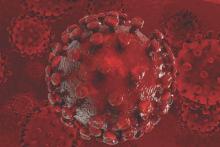A higher prevalence of tenofovir resistance was identified in patients with HIV infection living in low- and middle-income settings and with lower baseline CD4 cell counts, according to a retrospective cohort study.
Dr. Ravindra Gupta of the department of infection at University College London and colleagues in the TenoRes collaboration conducted a multicenter retrospective cohort study to analyze resistance rates in adult patients with HIV undergoing resistance testing secondary to failure of a first-line regimen containing tenofovir, a non-nucleotide reverse-transcriptase inhibitor (nevirapine or efavirenz), and a cytosine analogue (emtricitabine or lamivudine). The TenoRes cohort includes patients from Asia, sub-Saharan Africa, Latin and North America, and Europe (Lancet Infect Dis. 2016 Jan 28. doi: 10.1016/S1473-3099[15]00536-8).
Combination antiretroviral therapy (cART) recommendations by the World Health Organization include tenofovir with the non-nucleotide reverse-transcriptase inhibitor (NNRTI) efavirenz, and emtricitabine or lamivudine for adult HIV-1 infection.
From 1998 until 2015, data were analyzed on a cohort of 1,926 participants with treatment failure from 36 countries. Prior to ART initiation, the median CD4 count was 190 cells per mcL and 144 cells per mcL in Europe and North America, respectively, compared to a median CD4 count of 44-104 cells per mcL in Latin America, Asia, and sub-Saharan Africa. Further, the pretreatment viral load was higher in participants from Latin America and central, western, and eastern Africa.
Tenofovir resistance was highest in low- and middle-income settings and in sub-Saharan Africa (370/654, 57%). Factors associated with tenofovir resistance included the pre-ART CD4 cell count (OR 1.50, 95% CI: 1.27-1.77 for CD4 count less than 100 cells per mcL), use of lamivudine over emtricitabine (OR 1.48, 95% CI: 1.20-1.82), and use of the NNRTI nevirapine over efavirenz (OR 1.46, 95% CI: 1.28-1.67).
Tenofovir resistance was observed in 700 participants; 78% (n = 543) had major NNRTI resistance, 83% (n = 578) had the M184V/I mutation with cytosine resistance, and 65% (n = 457) were resistant to both.
Finally, participants with tenofovir resistance and those without had similar plasma viral loads at the time of treatment failure and a high baseline viral load was nonsignificantly associated with tenofovir resistance (OR 1.17, 95% CI: 0.91-1.44, for 100,000 or more copies per mL versus less than 100,000 copies per mL).
“CD4 cell count of less than 100 cells per mcL, treatment with nevirapine rather than efavirenz, and treatment with lamivudine rather than emtricitabine, were consistently associated with a 50% higher odds of tenofovir resistance in those with viral failure,” the researchers noted.
They hypothesized that differences in tenofovir resistance by region and income may be due to the frequency of patient follow-up and viral load monitoring with high-income patients receiving more frequent viral load testing and thus earlier detection of failure before resistance develops. They also said the association between tenofovir resistance and baseline CD4 counts highlights the benefit of CD4 testing at HIV diagnosis along with identifying opportunistic infection prophylaxis needs.
“Patient numbers were somewhat limited by the slow uptake of tenofovir-based regimens in west and central Africa, eastern Europe, and Asia ... and information about baseline viral load in these settings was uncommon. As a result, European countries, Thailand, and South Africa contributed substantially to the analysis,” the researchers wrote.
The Wellcome Trust funded the study. The authors reported multiple disclosures including stipends from various pharmaceutical companies.


